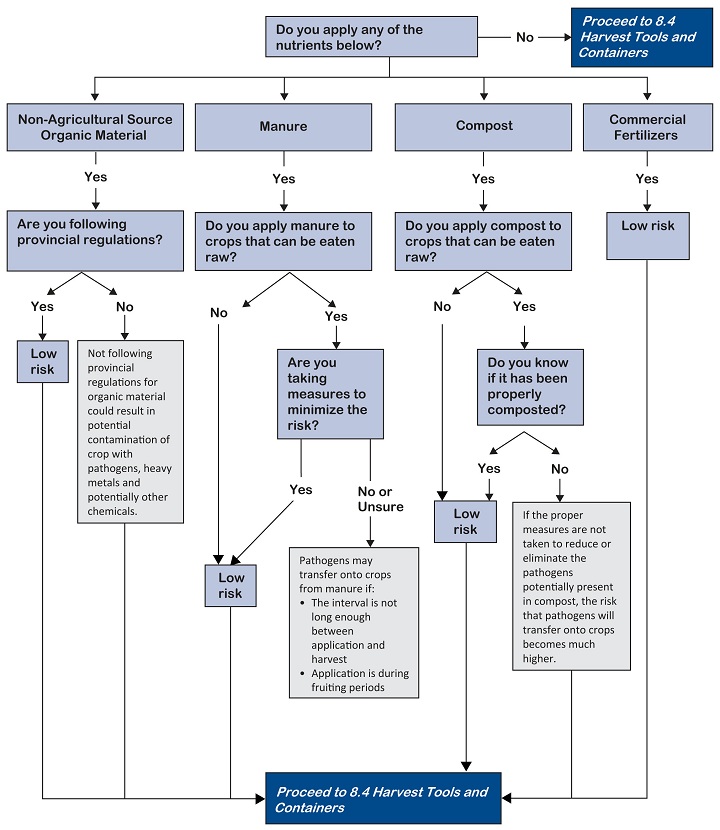Crops - 8.3 Nutrient use
Incorrect application of nutrients can contaminate crops. This good agricultural practice applies to all farms that apply nutrients to crops.
What needs to be done
Apply all nutrients in a way that will not pose a hazard to food.
How to do it
Generally speaking, the risk of applying commercial fertilizer (except nitrates) to crops is low. Use only fertilizers and soil additives that comply with the legal limits for heavy metals and bacteria.
For all nutrients:
- Use an application method or growing practice that minimizes the chance of the nutrient source contaminating the crop by coming into direct contact with the edible part of the crop. An example of this safe practice is growing crops on plastic
- Where possible, check purchased nutrients for documentation from the supplier that identifies the origin, treatment used, tests performed and the results of application
- Schedule applications in relation to both weather forecasts (for example, rain) and current soil moisture levels to avoid run-off to other sensitive areas (for example, adjacent harvestable crops, water sources)
- Determine soil fertility levels by regular soil sampling and analysis, and estimate crop needs. Follow recommended rates to avoid excess nutrient application
- Calibrate spreading equipment to ensure proper application rates
- For optimum application of nutrients see nutrient management planning in the British Columbia Environmental Farm Planning Nutrient Management Guide
Applying compost
Become informed about proper treatment procedures (for example, composting) that are designed to reduce or eliminate pathogens.
When purchasing compost, ask for a certificate of analysis or documentation of treatment method to ensure the composting process is complete.
When treating manure on-farm, record the treatment procedures (for example, composting, anaerobic digestion), detailing the date treated and the method used.
When treating manure on-farm, clean any equipment that is used to handle raw manure before handling finished compost so as not to re-introduce pathogens.
Applying manure
Incorporate manure into the soil within 24 hours to minimize contamination to adjacent crops from wind drift or run-off. Follow guidelines in the B.C. Environmental Farm Plan Reference Guide.
Take precautions when using untreated or partially treated manure (for example, aged) on fruits and vegetables that can be consumed raw or with minimal processing. Examples are:
- For crops that are not eaten raw or where the manure does not come into contact with the edible part: Apply manure when the time between application and harvest is greater than three months.
- For crops that can be eaten raw and where the manure can come into contact with the edible part: Apply manure when the time between application and harvest is greater than four months.
- In non-fruiting years for perennial crops: Apply manure when the application is not in the year of harvest.
When using non-agricultural source organic material
Apply organic material at recommended application rates and according to provincial regulations.
Before organic material can be applied to agricultural land, various approvals for the handling, storage and land application of the material may also be required.
Terms used in good production practice
Fertilizer is any material containing nitrogen, phosphorus, potassium or other plant food, manufactured, sold or represented for use as a plant nutrient.
Nutrient is any material applied to the land for the purpose of improving the growing of agricultural crops.
Non-agricultural source organic material is any material set out in Schedule 12 of Organic Matter Recycling Regulation that is suitable for composting. It includes sewage biosolids, yard waste and food waste.
Records to keep
The record requirements below can also be listed in a completed and approved nutrient management plan.
Keep a Nutrient application record or your own record that includes:
- The application date
- Type of nutrient
- Amount applied
- Weather conditions
- Time to incorporation
- Field identification, location and size
- Initials of the person that applied the nutrient
Keep an Organic material treatment record or your own record that includes
- Date
- Temperature
- Turning frequency
- Initials of person that applied the treatment
If you have an audit
Be prepared for an auditor to review:
- Nutrient application records
- Organic material treatment records, where necessary
- A letter of analysis from the supplier, when a compost was purchased
- A land application plan for when non-agricultural source organic material was used
Laws and regulations
Producers should use only fertilizers and supplements that have been registered, packaged and labelled to prescribed standards in the Fertilizers Act, R.S. 1985, c. F-10 and Fertilizers Regulations, C.R.C., c. 666.
Legislation
There is no specific provincial regulation for nutrient management, but farmers are encouraged to conduct nutrient management plans through the B.C. Environmental Farm Plan (EFP) Program and Investment Agriculture Foundation (IAF).
Use of manure and other agricultural wastes as fertilizer or soil conditioner is found in the Agricultural Waste Control Regulation, Reg. 131/92, Code of Agricultural Practice for Waste Management under the Environmental Management Act.
The Organic Matter Recycling Regulation, Reg. 18/02, s. 5 under the Environmental Management Act requires development of a land application plan prior to application of some defined nutrient sources such as Class A and B biosolids and Class A and B compost. Schedule 12 lists organic materials covered by the regulation.
Other regulations that may apply to organic nutrient use on farm in BC include Agricultural Land Commission Act, S.B.C. 2002, c. 36, and Agricultural Land Reserve Use, Subdivision and Procedures Regulation, Reg. 171/02. In addition, the Drinking Water Protection Act, S.B.C. 2001, c. 9 also apply to inputs used on land.

